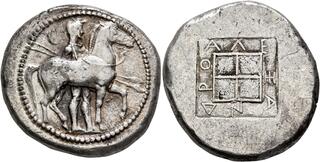| Leu Numismatik AG > Web Auction 28 | Auction date: 9 December 2023 |
| Lot number: 793 Price realized: 6,500 CHF (Approx. 7,389 USD / 6,862 EUR) Note: Prices do not include buyer's fees. | Show similar lots on CoinArchives Find similar lots in upcoming auctions on |
| Lot description: KINGS OF MACEDON. Alexander I, 498-454 BC. Oktadrachm (Silver, 33 mm, 28.68 g, 10 h), circa 479-475. Horseman, wearing chlamys and petasos, holding two javelins and walking slowly to right behind bridled horse standing right; to upper left, crescent; on the flank of the horse, kerykeion brand. Rev. AΛE-ΝA-NΔ-PO around quadripartite square in relief; all within rectangular incuse. Asyut 152. Raymond group II, 54. SNG ANS 23. Very rare. An impressive piece of vigorous late Archaic style. Numerous light marks and the obverse a bit weak and with very minor die rust, otherwise, very fine. From a European collection, formed before 2005. Influenced by the longstanding hostilities between the Macedonian Kings and Athens in the late 5th and 4th centuries, Greek commentators often stressed the alleged barbarism of the Macedonians, who lived in and around the Macedonian plain in Northern Greece and spoke a related Greek dialect. The earliest references to the Macedonian Kingdom, however, come from Herodotus, from whom we learn that the claim of Alexander I to be a descendant of Herakles and the Argives was accepted by a court of Elean hellanodikai possibly as early as 504 BC, which allowed him to participate (and win), as a Greek, in the Panhellenic Olympic Games. Alexander's father Amyntas I had been a vassal of the Persians since the advance of Dareios I to Europe in 512/1 BC, and his son and successor carefully maneuvered between the superpower Persia and the Greek city states in the South. The accounts given by Herodotus on his actions are rather confusing, but it appears that Alexander, while formally fulfilling his duties as a Persian vassal, secretly sided with the Greeks on several occasions, providing them with valuable information about the Persian's plans and movements - although it is unclear to what extent these stories are later extenuations. In 479 BC, Alexander personally spoke as an ambassador of the Persian commander Mardonius to the Athenians to win them over to the Great King's side, but he openly defected to the Greeks after Pausanias' resounding victory at Plataia and defeated the remaining Persian forces at the Strymon river during their retreat to Thrace. Little is known about Alexander's activities after the Persian invasion of 480/79 BC, but Herodotus mentions, en passant, that a gold statue of the Macedonian King was standing in Delphi in his day (Hdt. 8.121), which undoubtedly boasted Alexander's role in the defeat of the Persian invaders in front of a Panhellenic audience at a time when Medismos had long become a serious political accusation. It is likely that Alexander expanded the boundaries of his realm following the retreat of the Persians, and he also became the first Macedonian King to strike his own coinage. Our example belongs to Raymond's group II, which she dated to 476/5-460 BC, but the emergence of a related oktadrachm in the Asyut hoard, burried around 475 BC, strongly speaks for a somewhat earlier date. These heavy coins were struck to the Phoenician weight standard and they were likely intended for tribute payments and 'international' trade. Most of them winded up travelling east, where they were, as the common practice of cutting them to smaller pieces ('Hacksilber') shows, usually treated as bullion. As a consequence, finding unworn and unbattered examples is very rare today and this sharply struck piece is, thus, a remarkable exception to the rule and a fine example of the earliest coinage struck by the Macedonian Kings. Starting price: 2500 CHF |  |



